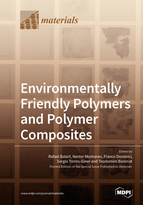Environmentally Friendly Polymers and Polymer Composites
A special issue of Materials (ISSN 1996-1944).
Deadline for manuscript submissions: closed (31 December 2019) | Viewed by 78507
Special Issue Editors
Interests: aliphatic polyesters; blends; compatibilization; advanced characterization; functional additives; unsaturated polyester resins; composites
Special Issues, Collections and Topics in MDPI journals
Interests: biopolymer composites; polymer characterization; green compatibilizers; chain extenders from renewable resources; circular economy; polymers and composites with functional properties; natural fibers composites; recycling
Special Issues, Collections and Topics in MDPI journals
Interests: high-performance polymers; nanoparticle additives for plastic formulations; biodegradation of polymers; polymer composites; biopolyesters; advanced manufacturing; composites
Special Issues, Collections and Topics in MDPI journals
Interests: bio-based and biodegradable polymers; green composites; polymerization of biopolymers; processing of bioplastics; nanofibers obtained by electrospinning; sustainable polymer technologies for food preservation; controlled release of active compounds in plastic formulations; biopolymers for food packaging; bioeconomy; circular economy
Special Issues, Collections and Topics in MDPI journals
Interests: polymer manufacturing; 3D printing; polyesters; medical applications; process modeling; computer-aided engineering (CAE); computer-aided manufacturing (CAM); polymer stents; fixation plates
Special Issues, Collections and Topics in MDPI journals
Special Issue Information
Dear Colleagues,
In the last few years, the problems related to plastic wastes have been aggravated. Conventional plastics are obtained from fossil fuels and are not, in general, biodegradable (or disintegrable in controlled compost soil). Our society is, every day, much more sensitive with regards to the environment and topics such as petroleum depletion, sustainable development, Circular Economy, waste management, and related issues, are gaining relevance.
For these reasons, important research in the field of environmental-friendly polymers and polymer composites has been observed in the last decade. These investigations include a wide range of materials that show environmental efficiency at different stages of the Life Cycle. e.g., only at the origin (polymers from renewable resources such as bio-based polyethylene-bioPE, polyamides-bioPA, polycarbonate-bioPC, and others), and only at the end (disintegrable petroleum-derived polymers, such as poly e-caprolactone-PCL, polyvinyl alcohol-PVA, polyglycolic acid-PGA, polybutylene succinate-PBS and copolymers).
In addition, important research is being conducted from a third stand point, which considers environmental efficiency at both the origin and the end of the Life Cycle. These investigations include the potential of polysaccharide-derived polymers (starch, cellulose, quitin and their derivatives such as starch-derived PLA, quitosan, and so on). Moreover, research on protein-based polymer formulations is also an interesting challenge for the polymer and composites industries as natural proteins, such as gluten, casein, ovalbumin, and collagen could be potentially used in industrial formulations. Finally, the industrial use of bacterial polyesters such as polyhydroxybutyrate-PHB, polyhydroxybutyrate-co-valerate-PHBV and other polyhydroxyalkanoates-PHAs, represents a challenging topic.
This Special Issue is intended to compile the most recent research works in any polymer or polymer composite with a marked environmental efficiency with the main aim of using them at industrial scale. Research on any biobased polymer, biodegradable polymer or both biobased/biodegradable polymer (and new additives or blends) is welcome. All manufacturing processes, e.g., injection molding, extrusion, electrospinning, cast film, melt spinning, rotational moulding, hot-press moulding, 3D printing, and so on, fit this Special Issue and could help to reveal the real potential of these materials. In addition, original research on polymer-based composites in which, the matrix, the reinforcement/filler or both could be obtained from renewable resources is welcome, e.g., research on natural fiber reinforced plastics (NFRPs) and wood plastic composites (WPCs).
The potential transfer of this research to industry could only be possible by increasing our knowledge about these materials, which includes an in depth knowledge of their mechanical properties (mathematical models and simulation), thermal behavior, use of environmentally friendly additives and fillers, advanced morphology characterization, manufacturing conditions and optimization of the processing window, rheology studies, compatibilization, interface phenomena, degradation/biodegradation and its kinetics, functional additives, and so on.
We hope all the research works included in this Special Issue help scientist to transfer new materials for industrial purposes, as well as to give an overall view of the potential of these environmentally friendly materials.
Prof. Dr. Rafael Balart
Prof. Dr. Nestor Montanes
Dr. Franco Dominici
Prof. Dr. Sergio Torres-Giner
Prof. Dr. Teodomiro Boronat Vitoria
Guest Editors
Manuscript Submission Information
Manuscripts should be submitted online at www.mdpi.com by registering and logging in to this website. Once you are registered, click here to go to the submission form. Manuscripts can be submitted until the deadline. All submissions that pass pre-check are peer-reviewed. Accepted papers will be published continuously in the journal (as soon as accepted) and will be listed together on the special issue website. Research articles, review articles as well as short communications are invited. For planned papers, a title and short abstract (about 100 words) can be sent to the Editorial Office for announcement on this website.
Submitted manuscripts should not have been published previously, nor be under consideration for publication elsewhere (except conference proceedings papers). All manuscripts are thoroughly refereed through a single-blind peer-review process. A guide for authors and other relevant information for submission of manuscripts is available on the Instructions for Authors page. Materials is an international peer-reviewed open access semimonthly journal published by MDPI.
Please visit the Instructions for Authors page before submitting a manuscript. The Article Processing Charge (APC) for publication in this open access journal is 2600 CHF (Swiss Francs). Submitted papers should be well formatted and use good English. Authors may use MDPI's English editing service prior to publication or during author revisions.
Keywords
- Environmentally friendly
- Bio-based polymers
- Natural fiber reinforced polymers (NFRPs)
- Wood plastic composites (WPCs)
- Petroleum-derived biodegradable polyesters
- Polysaccharide-derived polymers and composites
- Protein-derived polymers and composites
- Bacterial polyesters and composites
- Biobased additives and fillers
- Characterization (mechanical, thermal, electrical, piezoelectric, physical, chemical, morphology, etc.)
- Manufacturing (injection moulding, extrusion, reactive extrusion, 3D printing, melt spinning, rotational moulding, electrospinning, thermoforming, hot-press moulding, etc.)
- Engineering parts, films, fibers, components











